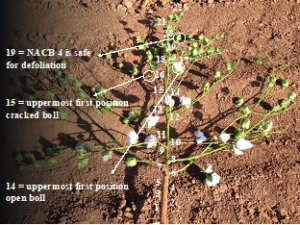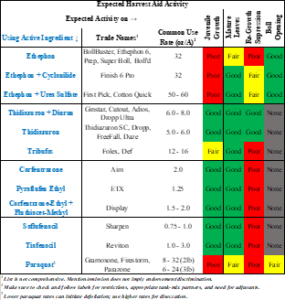Murilo Maeda, Extension Specialist – Cotton, Texas A&M AgriLife Extension Service
Wayne Keeling, Systems Agronomist, Texas A&M AgriLife Research
INTRODUCTION
Cotton is cultivated as an annual crop but is inherently a deciduous perennial. As such, it is a flexible crop that responds well to both environmental and management factors. Harvest-aid chemicals are generally used to facilitate mechanical harvest of a mature crop by promoting leaf abscission, boll opening, and desiccating plants for stripper harvest. Premature application of these chemicals can result in loss of lint yield and quality; therefore, an understanding of what each chemical does, as well as the best timing for defoliation are important. This guide is not meant to be comprehensive, but rather focused on preparing cotton for stripper harvest in the Texas High Plains. Please consult the labels for detailed information. This guide covers what, when, and how much.
HARVEST AID TYPES (What)
Defoliants: herbicidal types such as Reviton (newly registered), Ginstar, Folex, Aim, ETX, Display, Sharpen, and Paraquat (at low rates) usually cause leaf injury, which signals production of ethylene (stress hormone). Increased levels of ethylene will lead to the formation of an abscission layer at the base of the leaf petiole, causing leaf drop (Fig. 1).
Figure 1. The three phases of the hormonal control of leaf abscission (Morgan 1984).
Defoliants and Boll Openers: hormonal-type products such as Finish 6 Pro (ethephon + cyclanilide), Ginstar and Cutout (thidiazuron + diuron), ethephon (various formulations), and thidiazuron (various formulations) create plant stress and also induce production of the stress hormone ethylene. Increased ethylene levels trigger the formation of the abscission layer at the base of the leaf petiole and in the boll walls, ultimately leading to leaf drop and boll opening.
Desiccants: have the ability to desiccate leaves and prepare the crop for stripper harvest. Gramoxone (paraquat) is an example. It destroys green tissue by disrupting photosynthesis. This process happens rapidly, and the abscission layer does not have enough time to form. When used at high rates these products can cause leaves to desiccate but remain attached to the plant (stick).
TIMING (When)
Timing is key. Poor defoliation timing can negatively impact lint yield and fiber quality ($$$). Generally, 4 nodes above cracked boll (NACB) is safe for defoliation while 2 NACB is safe for desiccation (Fig. 2). See figure 3 for how to determine NACB. Note that harvest aid chemicals will not accelerate fiber development, and that there is no substitute to warm weather and time when it comes to fiber maturity.
Figure 2. Potential yield loss when determining harvest aid application timing based on nodes above cracked boll (NACB). Kerby et al. 1992.
Figure 3. Determining nodes above cracked boll (NACB).
When trying to determine the appropriate timing of harvest aid application, there are several methods to assess crop readiness. The most commonly used are:
- 40-60% open bolls
- Nodes above cracked boll (NACB) ≤ 4
- Knife method
Methods one and two are well correlated, with 60% open boll representing approximately 4 NACB (Fig. 4).
Figure 4. Nodes from uppermost first sympodial position cracked boll to the uppermost harvestable boll (NACB) vs. percent open boll. Red line indicate 60% open boll equals 4.1 NACB. Modified from Bednarz et al. 2002.
Method 3 consists of inspecting the uppermost boll you believe will contribute to yield by slicing it in a cross section. Mature bolls safe for defoliation will have a fully developed darkened seedcoat, be absent of any “jelly” like material, and be hard to cut (Fig. 5).
Figure 5. The knife method relies on slicing a cross section of the boll to determine maturity. Note the darkened seedcoat on the mature boll.
After applying harvest aids, it may take 7-14 days for the full effect, depending on weather conditions. Usually, defoliants and desiccants will take approximately 7 days, with hormonal products containing active ingredients such as ethephon and thidiazuron taking longer.
EXPECTATIONS & RATES (How Much)
THINGS TO CONSIDER
- Delaying harvest aid application can increase weathering losses
- Harvest aid chemicals are not very mobile (good coverage is important)
- When determining maturity, avoid relying on a single method
- Cooler weather reduces plant metabolism and harvest aid activity (higher rates may be required)
- For most irrigated cotton a two-shot program is required (boll opener + defoliant followed by a desiccant 7-10 days later)
- Match harvest aid application to harvesting capacity
- High rates of defoliants or desiccants, especially in warm weather can cause leaves to “stick”
- Avoid excessive late season fertilization and irrigation
- Drought stressed cotton is more difficult to defoliate
- Desiccants will interrupt development of immature bolls
- Remember restrictions on planting small grains following harvest aid application (thidiazuron, thidiazuron + diuron, ethephon, and ethephon + cyclanilide)
REFERENCES
Bednarz, C.W., W.D. Shurley, and W.S. Anthony. 2002. Losses in yield, quality, and profitability of cotton from improper harvest timing. Agron. J. 94:1004–1011.
Kerby, T.A., J. Supak, J.C. Banks, and C. Snipes. 1992. Timing defoliation using nodes above cracked boll. In D.J. Herber and D.A. Richter (Eds.) Proceedings of the Beltwide Cotton Conference. Nashville, TN. 6-10 Jan. 1992. National Cotton Council of America, Memphis, TN.
Morgan, P. W. 1984. Is ethylene the natural regulator of abscission? In Y. Fuchs, & E. Chaultz (Eds.), Ethylene: Biochemical, physiological, and applied aspects (pp. 231-240).





